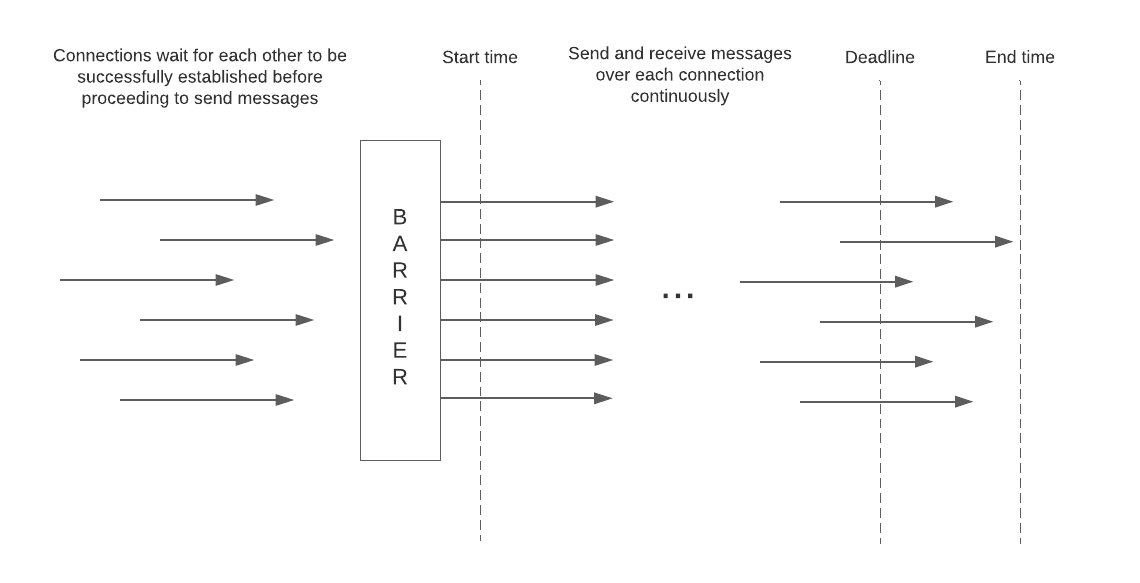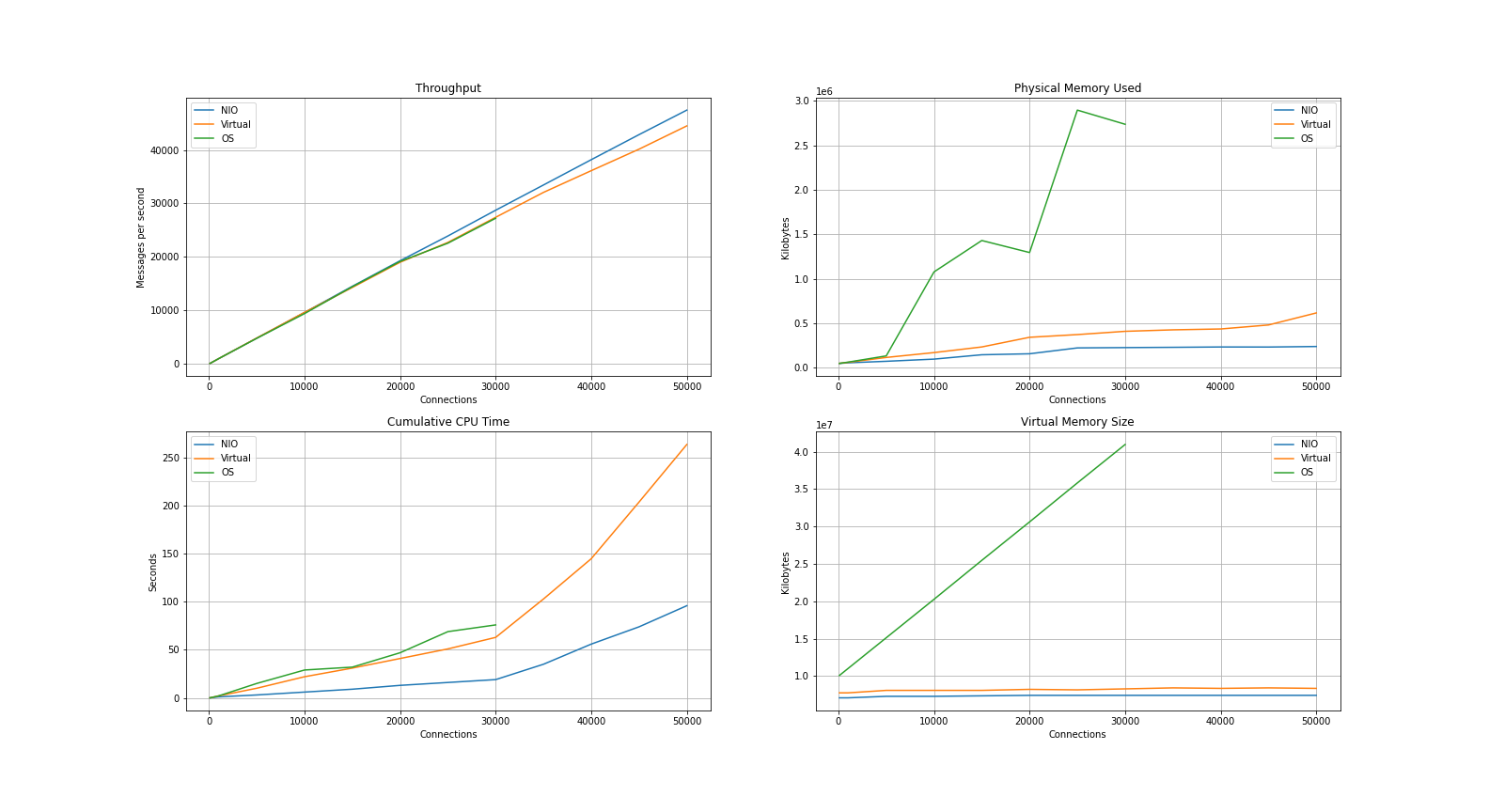Project Loom is the OpenJDK initiative to introduce user-mode threads in Java.
The purpose of this repository is to compare Project Loom virtual threads to two existing alternatives in the context of network applications: classic OS threads and non-blocking NIO.
Virtual threads are compared to the alternatives using an echo client-server protocol.
The server is tailored to maximize concurrent network connections and it supports a latency configuration for delaying echo responses by a precise amount. This introduced latency is indistinguishable from network latency from the client perspective.
In the results described below, a latency of 1 second was used.
Three echo clients are compared:
- Client built atop non-blocking NIO framework
- Client built atop classic OS threads
- Client built atop Project Loom virtual threads
Clients are configured to run with a target concurrency level in terms of number of connections and configured to run for a fixed duration.
The various test clients behave the same way:
- Establish persistent connections to echo server
- Wait for all connections to be successfully established before proceeding with echo requests
- Over each connection, send an echo request and receive an echo responses in a loop - when a response is received, immediately send subsequent request
- When the target duration is reached, allow trailing echo transactions to complete
- Measure throughput as the total number of echo transactions divided by the observed time elapsed
The NioEchoServer class is a long-running echo server application.
It supports the following command-line arguments:
- Host - hostname used for passive server socket binding
- Port - port number used for socket binding
- Buffer size - the size in bytes of the buffer used for received and replaying echo messages
- Latency - the delay to introduce between receiving an echo request and sending the response
- Resolution - select polling timeout that determines the frequency with which delayed echo responses are examined
- Accept queue length - queue length parameter set on passive socket bind
The NioEchoClient class is a single-threaded, non-blocking, NIO-based test driver application that runs for a fixed duration
at a target concurrent connection level. It supports the following command-line arguments:
- Host - hostname of the destination echo server
- Port - port number of the destination echo server
- Number of connections - the number of concurrent connections to use
- Content length - the size in bytes of each echo request message
- Duration - the target test duration in milliseconds
The ThreadedEchoClient class is a multi-threaded test driver application that runs for a fixed duration
at a target concurrent connection level. It supports the following command-line arguments:
- Host - hostname of the destination echo server
- Port - port number of the destination echo server
- Number of connections - the number of concurrent connections to use
- Content length - the size in bytes of each echo request message
- Duration - the target test duration in milliseconds
- Loom - boolean flag denoting whether to use virtual threads
The following experiment was conducted with two EC2 instances in AWS, one running the server and another running the client.
- Region:
us-west-2 - Instance type:
c5.2xlargecompute optimized instance 8 vCPU and 16 GB of memory - OS: Amazon Linux 2 with Linux Kernel 5.10, AMI
ami-00f7e5c52c0f43726
In order to facilitate the rapid creation of 50,000 connections, the following sysctl kernel parameter changes
were committed on both hosts prior to the start of the experiment:
sysctl net.ipv4.ip_local_port_range="2000 64000"
sysctl net.ipv4.tcp_fin_timeout=30
sysctl net.core.somaxconn=8192
sysctl net.core.netdev_max_backlog=8000
sysctl net.ipv4.tcp_max_syn_backlog=8192
Java classes were compiled and executed with an OpenJDK 19 Loom early access build: openjdk-19-loom+1-11_linux-x64
https://download.java.net/java/early_access/loom/1/openjdk-19-loom+1-11_linux-x64_bin.tar.gz
jdk-19/bin/javac --enable-preview --release 19 loomtest/*.java
The server instance used was started as follows:
jdk-19/bin/java loomtest.NioEchoServer <ip> 9000 32 1000 25 8192
The buffer size of 32 bytes was chosen to align with client configuration. The small magnitude was intended to minimize overhead associated with packet processing and copying. The goal of the tests is to surface concurrency scaling, not packet processing.
Similarly, the 1,000 millisecond latency was chosen to minimize the processing cost of each connection and to leave the focus on the costs associated with concurrency scaling.
Clients instances were started as follows:
jdk-19/bin/java --enable-preview loomtest.NioEchoClient <ip> 9000 <connections> 32 60000
jdk-19/bin/java --enable-preview loomtest.ThreadedEchoClient <ip> 9000 <connections> 32 60000 <loom>
The content size is set to a very low value of 32 bytes as noted above. Each test run had a target duration of 60,000 milliseconds.
The following range of values was used for number of connections: 100, 1000, 5000, 10000, 15000, 20000, 25000, 30000, 35000, 40000, 45000, 50000
Command for running every echo client:
for i in $(echo "100 1000 5000 10000 15000 20000 25000 30000 35000 40000 45000 50000"); do
jdk-19/bin/java --enable-preview loomtest.NioEchoClient 10.39.196.180 9000 $i 32 60000
sleep 120
done
for i in $(echo "100 1000 5000 10000 15000 20000 25000 30000 35000 40000 45000 50000"); do
jdk-19/bin/java --enable-preview loomtest.ThreadedEchoClient 10.39.196.180 9000 $i 32 60000 true
sleep 120
done
for i in $(echo "100 1000 5000 10000 15000 20000 25000 30000 35000 40000 45000 50000"); do
jdk-19/bin/java --enable-preview loomtest.ThreadedEchoClient 10.39.196.180 9000 $i 32 60000 false
sleep 120
done
Snippet of output from an execution of one client:
Args[host=10.39.196.180, port=9000, numConnections=50000, contentLength=32, duration=60000]
barrier opened!
duration: 61006 ms, throughput: 47446.906862 msg/sec
Metrics were gathered on the client host using the ps command:
while true; do ps -C java -o args:100,pcpu,c,cp,bsdtime,cputime,pid,pmem,rss,drs,trs,vsz; echo ""; sleep 1; done | tee ps.txt
Snippet of output from an invocation of ps:
COMMAND %CPU C CP TIME TIME PID %MEM RSS DRS TRS VSZ
jdk-19/bin/java --enable-preview loomtest.NioEchoClient 10.39.196.180 9000 50000 32 60000 76.5 76 765 1:36 00:01:36 10078 1.4 237488 7430752 3 7430756
The following diagram contains throughput data points reported by echo client executions and metrics reported by the ps command.
Throughput values are taken from the echo client standard output.
Cumulative CPU time values are taken from the cputime column of ps command output.
The cputime in the last row associated with a process is used as the representative value.
Physical memory size values are taken from the rss column of ps command output.
The maximum value among all rows associated with a process is used as the representative value.
Virtual memory size values are taken from the vsz column of ps command output.
The maximum value among all rows associated with a process is used as the representative value.
Echo client tests using classic OS threads failed to complete successfully at 35,000 connections.
The failure was caused by the inability to create pthread 32309. This appears to be due to memory
resource constraints on the host and not due to any limits placed on the system user.
The /proc/[pid]/limits values do not suggest any problematic limits.
Args[host=10.39.196.180, port=9000, numConnections=35000, contentLength=32, duration=60000, loom=false]
[11.235s][warning][os,thread] Failed to start thread "Unknown thread" - pthread_create failed (EAGAIN) for attributes: stacksize: 1024k, guardsize: 0k, detached.
[11.235s][warning][os,thread] Failed to start the native thread for java.lang.Thread "pool-1-thread-32309"
Exception in thread "main" java.lang.OutOfMemoryError: unable to create native thread: possibly out of memory or process/resource limits reached
at java.base/java.lang.Thread.start0(Native Method)
at java.base/java.lang.Thread.start(Thread.java:1466)
at java.base/java.lang.System$2.start(System.java:2510)
at java.base/jdk.internal.vm.SharedThreadContainer.start(SharedThreadContainer.java:144)
at java.base/java.util.concurrent.ThreadPoolExecutor.addWorker(ThreadPoolExecutor.java:952)
at java.base/java.util.concurrent.ThreadPoolExecutor.execute(ThreadPoolExecutor.java:1363)
at java.base/java.util.concurrent.AbstractExecutorService.submit(AbstractExecutorService.java:145)
at loomtest.ThreadedEchoClient.lambda$main$1(ThreadedEchoClient.java:94)
at java.base/java.util.stream.IntPipeline$1$1.accept(IntPipeline.java:180)
at java.base/java.util.stream.Streams$RangeIntSpliterator.forEachRemaining(Streams.java:104)
at java.base/java.util.Spliterator$OfInt.forEachRemaining(Spliterator.java:711)
at java.base/java.util.stream.AbstractPipeline.copyInto(AbstractPipeline.java:509)
at java.base/java.util.stream.AbstractPipeline.wrapAndCopyInto(AbstractPipeline.java:499)
at java.base/java.util.stream.AbstractPipeline.evaluate(AbstractPipeline.java:575)
at java.base/java.util.stream.AbstractPipeline.evaluateToArrayNode(AbstractPipeline.java:260)
at java.base/java.util.stream.ReferencePipeline.toArray(ReferencePipeline.java:616)
at java.base/java.util.stream.ReferencePipeline.toArray(ReferencePipeline.java:622)
at java.base/java.util.stream.ReferencePipeline.toList(ReferencePipeline.java:627)
at loomtest.ThreadedEchoClient.main(ThreadedEchoClient.java:95)
The plot above was creation with Python and matplotlib.
x = [100, 1000, 5000, 10000, 15000, 20000, 25000, 30000, 35000, 40000, 45000, 50000]
nio = {
'label': 'NIO',
'throughput': [...],
'cputime': [...],
'rss': [...],
'vsz': [...]
}
virtual = {
...
}
classic = {
...
}
import matplotlib.pyplot as plt
fig, axes = plt.subplots(2, 2)
ax11, ax21, ax12, ax22 = axes.ravel()
for d in [nio, virtual, classic]:
size = len(d['throughput'])
ax11.plot(x[0:size], d['throughput'], label=d['label'])
ax11.set_xlabel('Connections')
ax11.set_ylabel('Messages per second')
ax11.set_title('Throughput')
ax11.grid()
ax11.legend()
...
- NIO, classic OS threads, and virtual threads are all very effective concurrency tools. Even classic OS threads scaled to a concurrency level of 30,000 without issue.
- The overhead of virtual threads is remarkably low. The resource utilization of virtual threads was not significantly more than with NIO.
- The overhead of classic OS threads is indeed significant, particularly with respect to the process memory footprint. The cumulative CPU time of echo clients using platform threads is only marginally higher than the other echo clients.
- The slogan "codes like sync, scaled like async" is accurate. Virtual threads are an excellent alternative to asynchronous programming with non-blocking NIO.
In an attempt to verify that the NioEchoServer implementation wasn't a bottleneck or causing undue slowness,
I ran echo clients against a C echo server implementation built atop epoll.
This efficient and minimal echo server was almost a drop in replacement. Performance metrics were consistent with the Java implementation in this repository.

